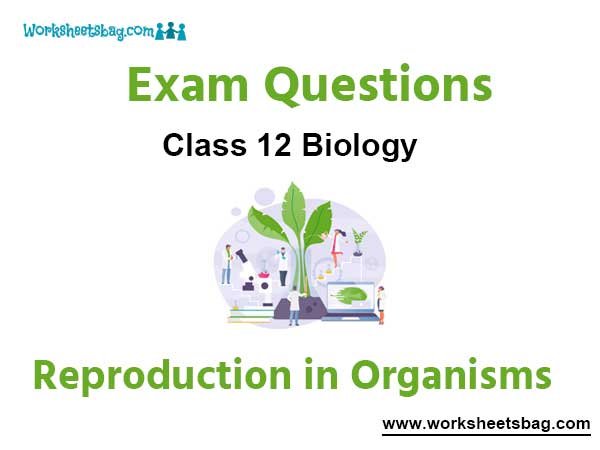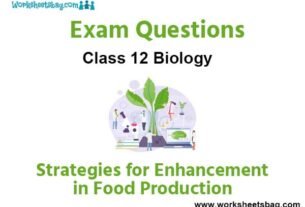Please see Chapter 1 Reproduction in Organisms Exam Questions Class 12 Biology below. These important questions with solutions have been prepared based on the latest examination guidelines and syllabus issued by CBSE, NCERT, and KVS. We have provided Class 12 Biology Questions and answers for all chapters in your NCERT Book for Class 12 Biology. These solved problems for Reproduction in Organisms in Class 12 Biology will help you to score more marks in upcoming examinations.
Exam Questions Chapter 1 Reproduction in Organisms Class 12 Biology
Very Short Answer Questions
Question. Is Marchantia monoecious or dioecious? Where are the sex organs borne in this plant?
Answer. Marchantia is dioecious. The male sex organs, antheridia, are borne on the antheridiophores and female sex organs, called as archegonia are borne on archegoniophores.
Question. Write the two pre-fertilisation events from the list given below: Syngamy, Gametogenesis, Embryogenesis, Pollination
Answer. Gametogenesis, Embryogenesis, Pollination.
Question. Which is a better mode of reproduction: sexual or asexual? Why?
Answer. Sexual mode of reproduction is better because it is biparental reproduction and introduces variation among offsprings and their parents (in a population) due to crossing over and recombination during gamete formation by meiosis and thus helps in better adaptation to changing environment.
Question. How is it possible in Oxalis and Viola plants to produce assured seed-sets even in the absence of pollinators?
Answer. By presence of cleistogamous flowers, hence anthers and stigma lie close to each other ensuring self-pollination.
Question. Mention the unique feature with respect to flowering and fruiting in bamboo species.
Answer. Bamboo species flower once in its life time generally after 50–100 years of vegetative growth. It produces large number of fruits and then dies.
Short Answer Questions
Question. A liverwort plant is unable to complete its lifecycle in a dry environment. State two reasons.
Answer. For sexual reproduction to take place in mosses and liverworts the motile male gametes,antherozoids, have to swim on the water surface to fertilise the immotile female gametes, egg.
In dry conditions, the antherozoids do not reach the egg and hence fertilisation cannot occur. So, the life cycle remains incomplete.
Question. Name the relationship between the first two words and suggest a suitable word (a) Doob grass : Runner : : Potato : ………… (b) Endogamy : Self-fertilisation : : Exogamy : …………
Answer. (a) Tuber (b) Cross-fertilisation.
Question. Mosses and frogs both need water as a medium for fertilisation. Where does syngamy occur and how is it ensured in both these organisms?
OR
Write the basis of categorising animals as oviparous or viviparous, giving one example of each.
Answer. In frogs, external fertilisation takes place in water. The frogs release large number of motile gametes. There is synchronised maturation of ova and sperms. In moss, internal fertilisation takes place. The male gametes are motile and are produced in large numbers.
OR
Oviparous animals are egg laying (fertilised or unfertilised). For example, reptiles, birds.
Viviparous animals give birth to young ones. For example, majority of mammals; humans.
Question. Why dogs and cats have oestrus cycle but human beings have menstrual cycle, though all are mammals?
Answer. Dogs and cats are seasonal breeders . They have heat period during which ovulation takes place.
Humans, on the other hand, have this cycle monthly.
Question. A single pea plant in your kitchen garden produces pods with viable seeds, but the individual papaya plant does not. Explain.
Answer. Flowers of pea plants are bisexual, hence can be self pollinated and produce pods with viable seeds.
Papaya is a dioecious plant bearing male and female flower on separate plants. It is unable to produce viable seeds as there is no cross-pollination. It could be a male plant which is unable to produce fruit and seeds.
Question. With which type of reproduction do we associate the reduction division? Analyse the reasons for it.
Answer. Reduction division is associated with sexual reproduction because the diploid organisms undergo meiosis to form haploid gametes.
Long Answer Questions
Question. Differentiate between an annual and a biennial plant. Provide one example of each.
Answer.
| S.No. | Annual plants | Biennial plants |
| (i) | These plants require a single season to complete their whole life cycle. | These plants require two seasons to complete their whole life cycle. |
| (ii) | They grow, set seeds and die within one year. | In the first year, they grow a healthy root system and short stem, i.e., show vegetative growth and become dormant in winters. In second year, they grow quickly, flower, set seeds and die. |
| (iii) | For example, rice, wheat, etc. | For example, onion, carrot, etc. |
Question. Although sexual reproduction is a long drawn, energy-intensive complex form of reproduction, many groups of organism in Kingdom Animalia and Plantae prefer this mode of reproduction. Give at least three reasons for this.
Answer. (a) Sexual reproduction brings about variation in the offspring.
(b) Since gamete formation is preceded by meiosis, genetic recombination occurring during crossing over (meiosis-I), leads to a great deal of variation in the DNA of gametes.
(c) The organism has better chance of survival in a changing environment.
Question. Why are offspring of oviparous animals at a greater risk as compared to offspring of viviparous animals?
Answer. In viviparous animals, the young one develops inside the body of the female organism. As a
result of this, the young one gets better protection and nourishment for proper development. In case of oviparous animals, they lay eggs and the young ones develop inside the calcareous shell, outside the body of the female. So, the young ones are not effectively protected and nourished and are vulnerable to predators. So, they are at a greater risk as compared to the offsprings of the viviparous animals.


